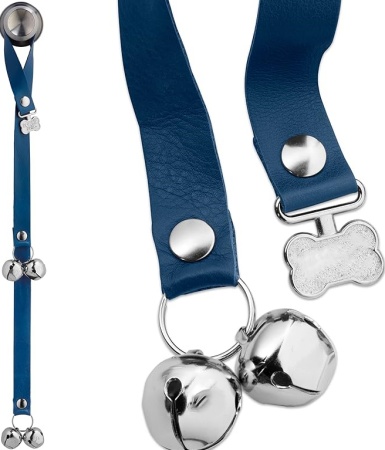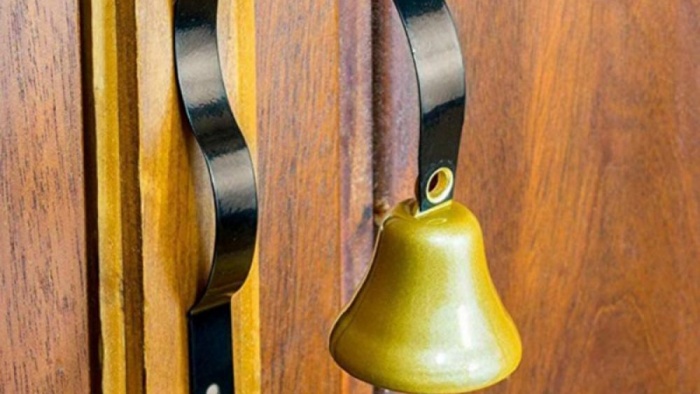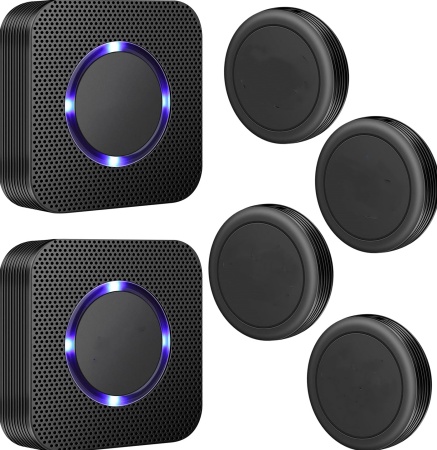
Dog Pee: Colors, Causes, and Hydration Tips
When it comes to dog pee, much like humans, the urine of animals is a vital health indicator. Just as human urine reveals a lot

Are you training your doggie doorbell manners, or does your furry friend incessantly scratch or bark at the door to go outside?
You need a dog doorbell! When nature calls, your dog can simply ring a bell, alerting you it’s time for a bathroom break.
We dedicated over 200 hours to testing 15 different dog doorbells.
We evaluated their durability, loudness, ease of installation, and how well they suit various dog breeds. All this was done to answer one straightforward question:
Which dog doorbell suits your furry friend best?
For Doorknobs
For Sliding Glass Doors
Permanent Solution
Curious about the best choice? Keep reading to find out!
In the category of doorbells that dangle from doorknobs, the PoochieBells stood out distinctly from others.
Just drape this dog doorbell over your doorknob. When your furry friend needs to relieve itself, a simple nudge or paw at the ribbon will jingle the bells – signaling it’s time for a bathroom break.
Being the sole type of dog doorbell that’s not fixed to a wall permanently, PoochieBells are a favorite for renters or those avoiding wall damage.

This dog doorbell is handcrafted in the USA. As expected from any American-made product, the quality of this doorbell is top-notch.
The four sleigh bells attached to the ribbon exemplify this. Made without lead, these bells resonate louder than any other hanging dog doorbell we evaluated. I could distinctly hear my dog’s signal to go outside from anywhere in my home.
The Poochie Bells also stand out as one of the few hanging doorbells available in various patterns and hues. From charming pink paw prints (my personal favorite!) to classic solid colors, there’s sure to be one that complements your home’s style!
Typically, doorknobs are positioned 36 inches off the ground. With a 26-inch length, the PoochieBells’ ribbon hangs about 10 inches from the floor.
This length was sufficient for even small puppies to reach. Our 8-inch tall Chihuahua tester, Mr. Cookie, could easily sound the lower bells. If your doorknob is higher and you have a tiny dog, consider a longer hanging dog doorbell. Always measure before purchasing!
All our canine testers quickly adapted to using this hanging doggy doorbell with ease. Regardless of whether they pawed or nudged the bells with their nose, the chimes resonated loudly throughout the house.
Note, this dog doorbell is exclusively suitable for doorknobs and handles that allow looping. If you have a sliding glass door, my next recommendation will suit you better.
Or, you could opt for a temporary hook to hang the Poochie Bells next to your door.
The benefit of a temporary hook is that the doorbells won’t sound every time the door is opened or closed.
For the ultimate hanging dog doorbell for your pet, the PoochieBells reign supreme. They’re loud, user-friendly, and American-made – truly a top-notch choice!
In our tests, we realized most hanging dog doorbells aren’t compatible with sliding glass doors – they kept slipping off.
The unique curved handles on these doors prevent the hanging of a standard dog doorbell.
That led us to identify a top choice specifically for those with patio door handles, and Caldwell’s Potty Bells is unbeatable in this category.
At the top of this doorbell, multiple rivets are present. Just thread the ribbon through your patio door handle and fasten the rivets. Voilà! Your doggie doorbell is securely in place!
Measuring 26 inches in length, the Potty Bells dangle low enough for even the tiniest puppies to reach. Our diminutive 8-inch tall Chihuahua tester was the perfect proof!
The length the Potty Bells hang down depends on your door handle’s design. In my neighbor’s house, it was 10 inches off the ground, whereas my aunt’s oversized patio handles reduced the gap to just 5 inches.
Thankfully, there’s some flexibility. The ribbon comes with two sets of rivets, allowing you to adjust the length of the bells by a few inches.
With its dual bell sets, the Potty Bells ring with minimal effort. While audible throughout my house, our dogs had to nudge them with more vigor compared to the previously mentioned product.
I appreciated the variety of color options for the Potty Bells. The white ones caught my eye, but I ultimately chose black, as it showed fewer marks.
For those with sliding glass doors looking to install a dog doorbell, Caldwell’s Potty Bells are the optimal choice. Highly recommended.
Let’s be upfront here: most fixed dog doorbells we evaluated were disappointing. Their Achilles’ heel? The point where the bell attaches to the metal strap via a pop rivet. In our tests, all such models failed – except for one…
Enter the GoGo Bell Deluxe, striking the perfect balance between affordability and sturdiness. Even our robust Pit Bull tester couldn’t damage it, despite their enthusiastic pawing.

Be warned, this bell is loud. The brass bell emits a resounding “clang” that’s audible from four rooms away. I could even hear it on the TV! If your hearing isn’t quite sharp, this dog doorbell is ideal for you.
However, if you’re noise-sensitive or live in a smaller space, you might find it excessively loud.
What really sets it apart is the bell’s size. At 2 inches wide, it’s noticeably larger than others, making it easier for our less coordinated dogs to ring it while eagerly waiting to go out.
An added bonus is its 6-inch distance from the wall, reducing the likelihood of wall stains or nose prints. Plus, its mounting height is adjustable, so you can place it perfectly for your dog’s reach.
Wondering about the ideal mounting height? We set it just high enough for our dogs to nose the bell comfortably.
My only gripe is the short length of the included screws. For a more secure installation, I’d recommend picking up longer screws from Home Depot or a local hardware store.
For a robust and long-lasting dog doorbell, the GoGo Bell Deluxe is top-tier. Highly recommended!
The installation is straightforward. Simply plug the receiver into an outlet, affix the activator button near your door, and you’re all set. When your dog presses the activator, the receiver emits a chime – completely wire-free!
What I especially appreciate about this wireless dog doorbell is its battery-free design. If you’re like me, you’ll know batteries often die at the worst times – not having to replace them is a huge plus.
It was fun to discover that I could choose from 38 different ring tones, ranging from a classic ding-dong to the Nut Cracker tune. With so many choices! Ultimately, I settled on the ding-dong as the longer chimes were too lengthy for my liking.

But customization doesn’t stop there. You also have four volume settings to choose from. In all the homes we tested, the medium volume was optimal – placing the receiver at the stair’s base ensured it was audible in a two-story house.
If you have a larger home or impaired hearing, don’t worry. If the Smart Bell’s loudest setting isn’t loud enough, you can add extra receivers. This way, you can have one near your bed, in the kitchen, or any place with an electrical outlet. No matter where you are in your home, you won’t miss your dog signaling it’s time to go out.
Additionally, the receiver lights up when activated. While I didn’t find this feature very useful (since mine was behind my couch), my elderly neighbor loved the visual cue to let the dog out.
To avoid accidental ringing, the Smart Bell needs 0.75 pounds of pressure to activate. That wasn’t an issue, though. Even our tiny tester, Mr. Cookie, managed to trigger the bell, albeit with some effort.
All our larger dogs easily pushed the button.
Through testing, I determined the ideal mounting height is just above your dog’s nose level. This prevents them from scratching at it and marking the wall.
Like adding more receivers, you can also install additional activators. I recommend getting the kit with two activators, allowing you to place one outside so your dog can tell you when it wants to come back in.
Plus, the Smart Bell activator is weatherproof. Throughout our tests, it withstood everything Mother Nature could throw at it – including heavy rain and intense sunlight.
Installing the activator is effortless. It comes with double-sided 3M tape on the back. Just peel off the sticker and attach it to drywall, glass, or even your wooden floor for your dog to step on!
There’s also an option for permanent installation. The faceplate removes easily, allowing you to drill through the base and screw it into drywall or brickwork.
For a wireless dog doorbell solution, the Doggy Dog Doorbell is an outstanding choice. Highly recommended.
While our top selections excelled, some dog doorbells we tested didn’t quite meet our standards.
It’s not that these doorbells are inherently bad. They all function, ringing when a dog paws or nudges them.
However, our testing led us to conclude that there are better options available than these particular models.
For those seeking a more upscale option, we did find one leather-strap model with a pleasant jingling sound. This American-made product had 10 bells, which we found a bit too sensitive, reacting to minimal movement. Nevertheless, its leather strap was a nice touch compared to the more common canvas straps.
Another hanging doorbell we tested came with the expectation of receiving two units, but only one was delivered. Functionally adequate, it was limited in color choices, and its smaller bells were not as loud as those on other models. A similar design we tested broke during our review process.
A notable wireless contender required batteries and lacked options for separate receivers and buttons, leading us to overlook it.
An older model wireless doorbell proved to be unreliable. Despite its longevity on the market, it didn’t consistently chime when activated, regardless of the dog’s breed or even human interaction.
One hanging doorbell, featuring an extra inch in length and a unique floral design, caught our eye. However, its bells were quieter than others we tested.
Another model was akin to a service bell seen in hotel lobbies, but with a larger, paw-friendly button. While it sat on the floor, it was easily moved or toyed with by larger dogs and playful puppies. If you’re looking for a reliable floor-mounted option, we recommend one of the earlier models we approved.
We advise against one particular model that had its bell detach during testing. Another similar design had its metal strip bend out of shape quickly, rendering it unsuitable for larger dogs.
Imagine being a dog, urgently needing to go outside, only to find the backdoor closed.
Here’s the catch…
You can’t speak, and those paws can’t turn doorknobs.
Left with no choice, you end up relieving yourself indoors.
This scenario is quite common, particularly during potty training.
Yes, your dog might whine or scratch at the door to signal their need. But what if you’re in another room or own a quieter breed? You might miss their cues.
That’s where a dog doorbell steps in…
Set up a dog doorbell near your door. When your dog taps it, it sounds off, signaling to you that they want to go out. It’s an effective way to grab your attention.
Typically, dogs ring the bell when they want to exit to the yard or balcony. These doorbells can also be mounted outside for when your dog wants to come back in.
Dog doorbells come in three styles:
Select a doorbell that
suits your dog’s needs. For instance, if your dog is a strong chewer, a hanging doorbell might not be the best choice. An all-metal design would be more durable.
Remember, if you ever see your dog misusing any product, including doggy doorbells, remove it immediately for safety.
Dog doorbells aren’t necessary for everyone. If your home already has a doggy door, then a dog doorbell might be redundant. A doggy door offers your pet the freedom to enter and exit at will, without needing your assistance.
But, if you are…
Then a dog doorbell could be an excellent solution for you!
Our philosophy is clear: we don’t endorse any product we wouldn’t use for our own dogs.
Therefore, we rigorously tested, compared, and reviewed each dog doorbell included in this guide. Altogether, over 200 hours were dedicated to testing various dog doorbells.
The initial step was to select the dog doorbells for review. This involved consulting dog owners who use dog doorbells, speaking with pet store owners, and analyzing thousands of online reviews.
Our research revealed that while the market is flooded with hundreds of dog doorbells, most are just slight variations of a few basic designs. This insight made the selection process much more manageable.
We purchased over 15 different dog doorbells from various retailers, paying the full retail price just like any other customer.
Then, we gathered a diverse group of dog testers, ranging from a tiny Toy Chihuahua to a large Boxer Foxhound, including breeds like Labrador, Jack Russell Terrier, Pit Bull Terrier, and Miniature Australian Shepherd. We also engaged additional neighborhood dogs, including a Great Dane and another Labrador, to test the doorbells on a wide array of doors, such as sliding glass patio doors.
Admittedly, the testing took longer than anticipated, primarily because most dogs had to be trained to use the doorbells, with only a couple being previously familiar.
We used the smallest tester, a Toy Chihuahua, to assess whether each doorbell was suitable for small puppies. Standing at just 8 inches tall, this little dog had to be retained for each type of doorbell.
We then evaluated each dog doorbell based on several criteria:
After an extensive 200-hour review process, we are confident that our top selections excel in all these aspects.
During our comprehensive testing of each dog doorbell, we noted several key observations worth mentioning:
After choosing the right dog doorbell for your pet, the next step is training them to use it.
Fortunately, training is simpler than it might seem. We utilized a highly effective training video for guidance:
Even our senior Labrador learned to use a dog doorbell, although it required a generous amount of treats, a good dog clicker, and a few weeks of patience. Stubborn as the old pup was, they eventually got the hang of it.
Training other dogs was generally quicker, ranging from a few days to a week. Dogs already familiar with treat training picked up the doorbell to use the fastest.
We observed that dogs trained to paw at the doorbells often scratched the wall behind, leaving scuff marks and peeling paint. This is particularly a problem if you have painted walls or wooden doors.
Even with neatly trimmed nails, a pawing dog can still cause damage. For example, one of our pawing dogs managed to knock down a wireless dog doorbell that was attached with tape.
In contrast, dogs trained to nudge the bell with their noses caused far less damage, with at worst a few nose prints to clean off – no lasting harm done.
For pawing dogs, consider wall protection like a clear, removable sticker placed behind the dog doorbell to shield the wall.
Hanging dog doorbells, while popular due to their easy installation and non-permanent nature (great for renters), have a potential downside: the sleigh bells used can have small holes that might catch a dog’s nails.
Though the likelihood of a nail getting snagged is low (we didn’t encounter any such incidents during our tests), a small risk remains. This was corroborated by a handful of reviews from thousands, where owners mentioned such incidents.
This reinforces the advantage of training your dog to use their nose instead of paws, reducing the risk of snags and wall damage.
Wow, if you’ve reached this point, well done! You are now equipped with the knowledge to select the ideal doggie doorbell for your furry friend.
How long does it typically take to train a dog to use a dog doorbell?
The training time can vary depending on the dog’s familiarity with treat training and their overall temperament. Generally, it can take anywhere from a few days to a few weeks. Using effective training methods like those found in specific training videos can help speed up the process.
Are dog doorbells suitable for all dog sizes and breeds?
Yes, most dog doorbells are designed to cater to a variety of dog sizes and breeds. However, it’s important to choose a doorbell that suits your dog’s specific needs, such as a longer hanging doorbell for taller dogs or a robust, chew-resistant model for more aggressive chewers.
Can dog doorbells be used on different types of doors?
Absolutely. There are dog doorbells designed for various door types, including doorknobs, sliding glass doors, and even for permanent wall mounting. It’s essential to choose the right type based on your door’s design and your living situation, such as renting versus owning.
Is it difficult to install a dog doorbell?
Installation difficulty varies by type. Hanging doorbells are usually the easiest, requiring no tools and just a few seconds to set up. Wireless doorbells might need a bit more time for placement and setup, while permanent doorbells could require basic DIY skills for secure installation.
What should I do if my dog is damaging the wall or door while using the dog doorbell?
If your dog tends to paw at the doorbell and damage the surrounding area, you might want to train them to use their nose instead. Alternatively, you can protect your walls or doors by using clear, removable protective stickers behind the doorbell. This helps to prevent scuff marks and scratches.


When it comes to dog pee, much like humans, the urine of animals is a vital health indicator. Just as human urine reveals a lot

Noticed your dog yawn more often than usual? While it’s adorable, it could also be a sign of something to consider if it appears excessive.

Wondering what’s so fantastic about bell train a dog? Picture a world where your furry friend always alerts you when they need to go outside,

A potty doorbell is essentially a bell placed near your entrance that your dog can ring to indicate her need to go potty. No matter

Are you training your doggie doorbell manners, or does your furry friend incessantly scratch or bark at the door to go outside? You need a

When it comes to dog pee, much like humans, the urine of animals is a vital health indicator. Just as human urine reveals a lot

Noticed your dog yawn more often than usual? While it’s adorable, it could also be a sign of something to consider if it appears excessive.

Wondering what’s so fantastic about bell train a dog? Picture a world where your furry friend always alerts you when they need to go outside,
Copyright © 2024 doggydogdoorbell. All Rights Reserved.